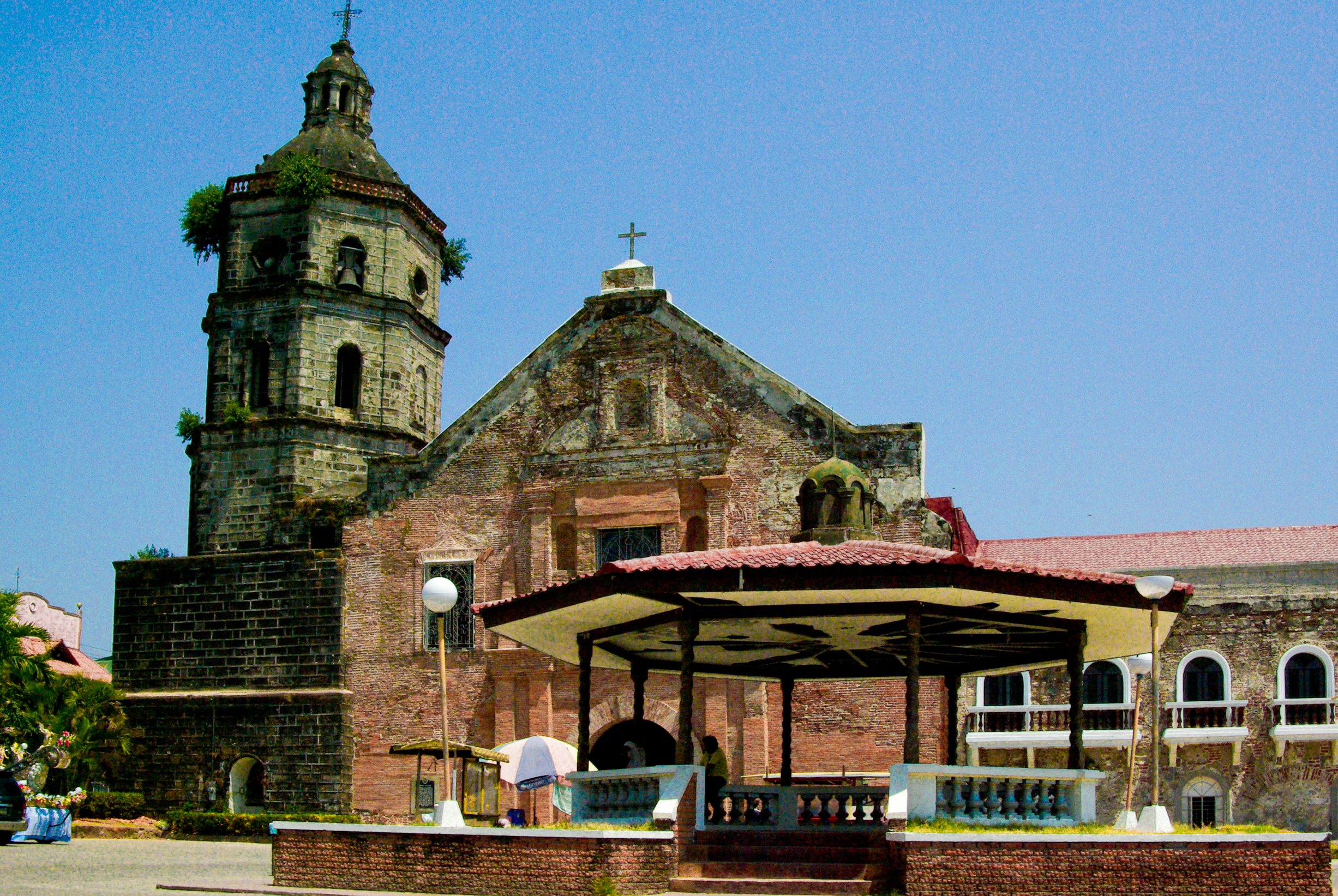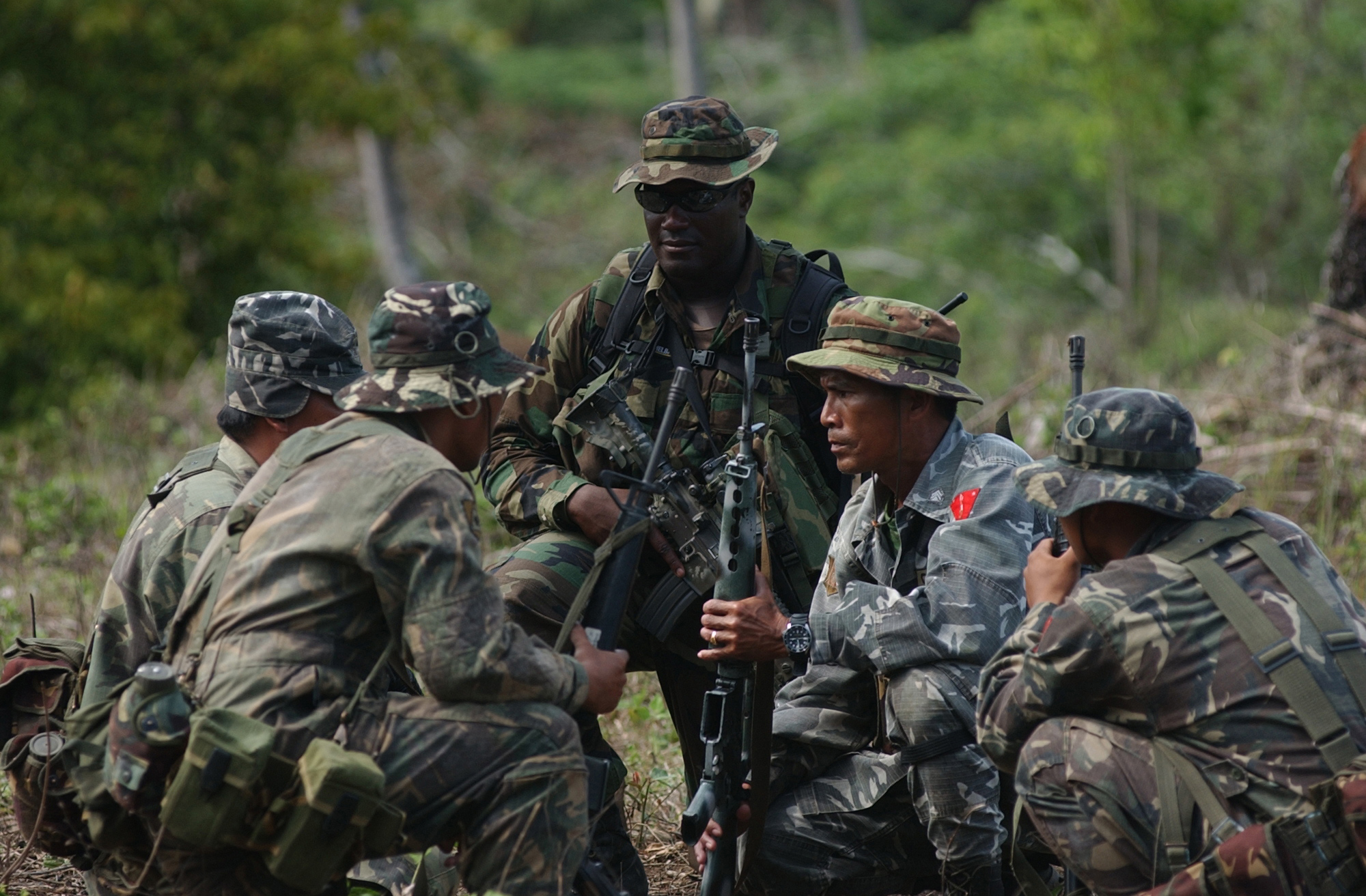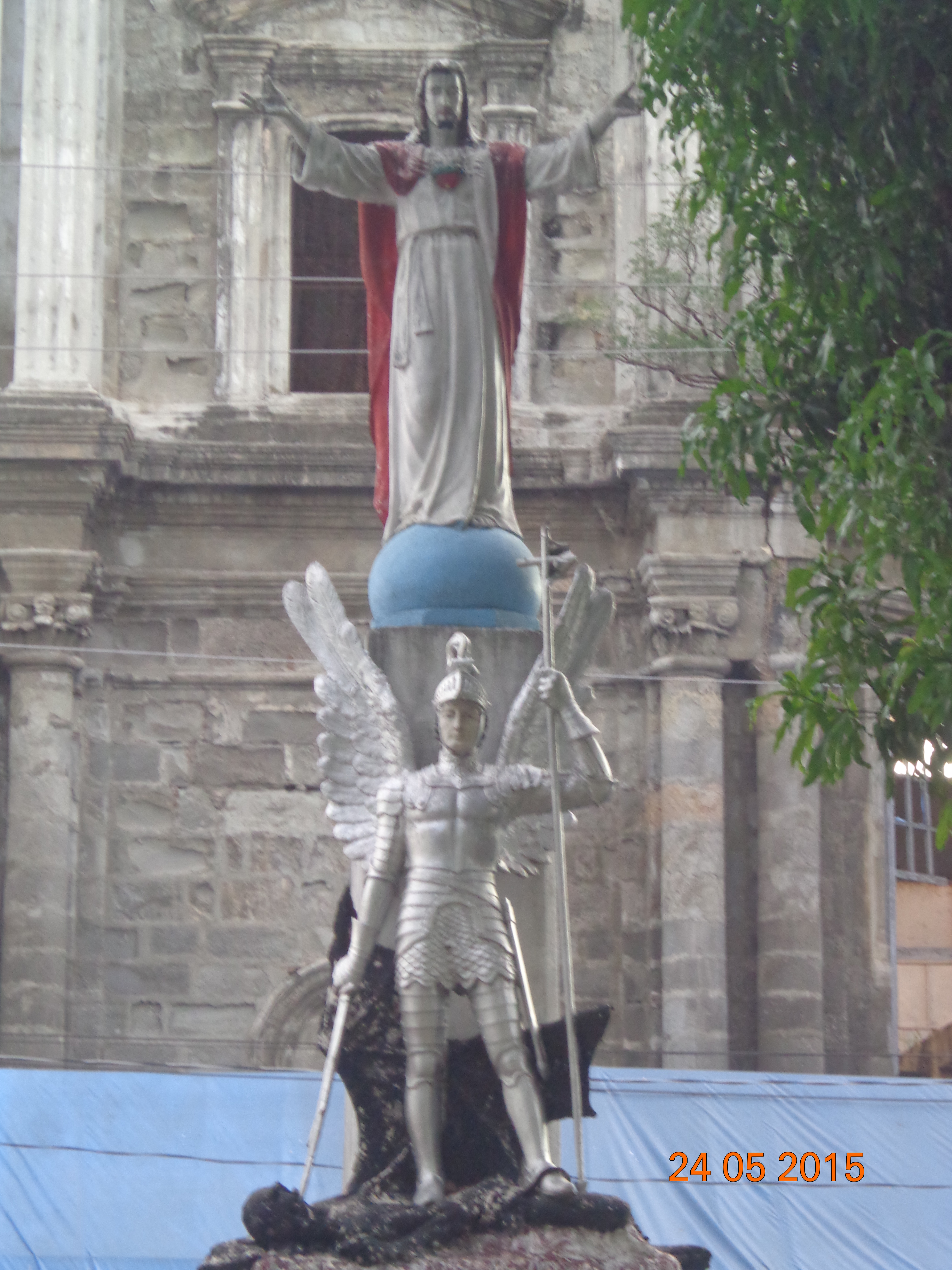|
Zambales Mountains
The Zambales Mountains is a mountain range on western Luzon island in the Philippines. The mountains separate Luzon's central plain from the South China Sea. Its most prominent section is known as the Cabusilan Mountain Range composed of Mount Pinatubo, Mount Negron and Mount Cuadrado, which are believed to be remnants of the ancestral Pinatubo peak. The highest elevation in the Zambales Mountains is Mount Tapulao, also known as High Peak, in Zambales province which rises to . Extent The Zambales Mountains has an area of extending North to South from the mountains of western Pangasinan province, the whole length of Zambales, to tip of the Bataan Peninsula in the south enclosing Manila Bay.Smith, Warren D. (1913)"Journal of Geology, Vol. 21 – The Geology of Luzon, P.I." pp. 39–40. University of Chicago, Department of Geology. The mountain range also encompasses the mountains in the municipalities of Bamban, Capas, San Jose, San Clemente, Mayantoc, Santa Ignacia, Cam ... [...More Info...] [...Related Items...] OR: [Wikipedia] [Google] [Baidu] |
San Narciso, Zambales
San Narciso, officially the Municipality of San Narciso ( ilo, Ili ti San Narciso; tl, Bayan ng San Narciso), is a 4th class municipality of the Philippines, municipality in the Philippine Province, province of Zambales, Philippines. According to the 2020 census, it has a population of 30,759 people. San Narciso is famous for its beaches along the South China Sea that are suited for surfing. Many local celebrities have already visited San Narciso to surf in its beaches which is from Iba, Zambales, Iba, from Olongapo, and from Manila. The Philippine Merchant Marine Academy or PMMA is located here. San Narciso also houses the Magsaysay Memorial College, which offers bachelors courses and other 2-year courses. Also located in San Narciso is the Zambales Academy, one of the oldest secondary education institution in the province, it is where former president Ramon Magsaysay took his secondary education. History The Municipality of San Narciso was founded in the early part of 18th ... [...More Info...] [...Related Items...] OR: [Wikipedia] [Google] [Baidu] |
Bamban, Tarlac
Bamban, officially the Municipality of Bamban ( pam, Balen ning Bamban; fil, Bayan ng Bamban), is a 2nd class municipality in the province of Tarlac, Philippines. According to the 2020 census, it has a population of 78,260 people. The municipality of Bamban is the southernmost gateway of the melting pot province of Tarlac in the Central Plain of Luzon in the Philippines. Being the southernmost town in the province, it has a common boundary with Mabalacat, Pampanga, and in the west, with Zambales. The boundary is defined by the Parua River, which is a source of irrigation water, food, and sand and gravel for infrastructure projects. The mountainous region situated in the western part comprises almost two-thirds of the total land area, which used to be within the US Military Reservations. Nestled in this part are the BLISS projects and to the north, the MAR settlement project, which when completely developed will be a source of livelihood and food supplies for Central Luzon. Bamb ... [...More Info...] [...Related Items...] OR: [Wikipedia] [Google] [Baidu] |
Mabalacat
Mabalacat, officially the City of Mabalacat ( pam, Lakanbalen ning Mabalacat; fil, Lungsod ng Mabalacat), is a 3rd class component city in the province of Pampanga, Philippines. According to the 2020 census, it has a population of 293,244 people. Etymology The town's name was derived from indigenous Negrito word ''mabalacat'' meaning "forest of balacats". Geography Mabalacat has a land area of . It is from Manila, from Angeles, and from the provincial capital, San Fernando. The soil is charcoal black and shiny, a sign of fertility, and is suitable for growing rice, sugarcane and other rootcrops. Like the neighbouring cities of Angeles and San Fernando and the towns/municipalities of Porac, Bacolor, Santa Rita, Mexico, Magalang and Arayat, this city rarely gets inundated by floods from heavy rains and typhoons because it is situated on an elevated, well-drained part of the Central Luzon plains known as the "Upper Pampanga". Barangays Mabalacat is politically subdivid ... [...More Info...] [...Related Items...] OR: [Wikipedia] [Google] [Baidu] |
Angeles City
, anthem = Himno ning Angeles (Angeles Hymn) , subdivision_type3 = District , subdivision_name3 = , established_title = Settled , established_date = 1796 , established_title1 = Chartered , established_date1 = December 8, 1829 , established_title2 = Cityhood , established_date2 = January 1, 1964 , established_title3 = Highly urbanized city , established_date3 = October 13, 1986 , parts_type = Barangays , parts_style = para , p1 = (see Barangays) , leader_title = , leader_name = Carmelo G. Lazatin Jr. , leader_title1 = Vice Mayor , leader_name1 = Maria Vicenta L. Vega , leader_title2 = Representative , leader_name2 = Carmelo B. Lazatin II , leader_title3 = Councilors , leader_name3 = , leader_title4 = Electorate , l ... [...More Info...] [...Related Items...] OR: [Wikipedia] [Google] [Baidu] |
Lubao
Lubao, officially the Municipality of Lubao ( pam, Balen ning Lubao; fil, Bayan ng Lubao), is a 1st class municipality in the province of Pampanga, Philippines. According to the 2020 census, it has a population of 173,502 people. It is noted for rice, sugar cane, fish, and sampaguita. Etymology The town's name derives from the indigenous term ''lubo'' which means low or sunken, reflective of the area's muddy and flooded characteristics. Lubao is also known by its Kapampangan language equivalent Baba. Geography Located in the south-western part of Pampanga, Lubao is bounded by the municipalities of Sasmuan on the east, Guagua on the north-east, Floridablanca on the north and Hermosa, Bataan, on the south. Lubao is from San Fernando, from Angeles, and from Manila. Barangays Lubao is politically subdivided into 44 barangays. Cluster 1: * San Isidro * Santiago * Santo Niño (Prado Saba) * San Roque Arbol * Baruya (San Rafael) * Lourdes (Lauc Pau) * Prado Siongco Clus ... [...More Info...] [...Related Items...] OR: [Wikipedia] [Google] [Baidu] |
Porac
Porac, officially the Municipality of Porac ( pam, Balen ning Porac; fil, Bayan ng Porac), is a 1st class municipality in the province of Pampanga, Philippines. According to the 2020 census, it has a population of 140,751 people. The Subic–Clark–Tarlac Expressway (SCTEx) traverses this town, the exit of which is located in Barangay Manuali. With an area of , Porac is the largest town in Pampanga. It was once among the largest municipalities in the archipelago before it was divided into separate municipalities. History Porac was founded on October 31, 1594, upon acceptance by Fray Mateo Peralta in the Friar's Intermediate Chapter (recorded by Fray Gaspar de San Agustin, by saying Porac has its First Minister and Friar, Fray Mateo de Mendoza. The General Headquarters and Military Camp Base of the Philippine Commonwealth Army and Philippine Constabulary was stationed in Porac from 1942 to 1946 and the local military operates against the Imperial Japanese military and local co ... [...More Info...] [...Related Items...] OR: [Wikipedia] [Google] [Baidu] |
Floridablanca, Pampanga
Floridablanca, officially the Municipality of Floridablanca ( pam, Balen ning Floridablanca; fil, Bayan ng Floridablanca) is a 1st class municipality in the province of Pampanga, Philippines. According to the 2020 census, it has a population of 135,542 people. Floridablanca is a part of the province of the Pampanga located in Central Luzon lying north of Dinalupihan, Bataan and south-southwest of San Fernando, Pampanga. History Floridablanca was founded in 1823 at the site of a monastery. In the 1920s, the Pampanga Sugar Mill was built at Del Carmen in the 1920s. The area was the site of military bases of the Philippine Commonwealth Army and the Philippine Constabulary from 1942 to 1946. The Philippine Air Force established Basa Air Base at a former American military airfield in 1947. Geography Floridablanca is located on the western part of Pampanga along the Zambales mountain ranges and is bounded by the municipalities of Porac on the north, Lubao on the south ... [...More Info...] [...Related Items...] OR: [Wikipedia] [Google] [Baidu] |
Pampanga
Pampanga, officially the Province of Pampanga ( pam, Lalawigan ning Pampanga; tl, Lalawigan ng Pampanga ), is a province in the Central Luzon region of the Philippines. Lying on the northern shore of Manila Bay, Pampanga is bordered by Tarlac to the north, Nueva Ecija to the northeast, Bulacan to the east, the Manila Bay to the central-south, Bataan to the southwest and Zambales to the west. Its capital is the City of San Fernando. Angeles City is the largest LGU but while geographically within Pampanga, it is classified as a first-class, highly urbanized city and has been governed independently of the province since it received its charter in 1964. The name ''La Pampanga'' was given by the Spaniards, who encountered natives living along the banks (''pampáng'') of the Pampanga River. Its creation in 1571 makes it the first Spanish province on Luzon Island (Cebu in Visayas is older as it was founded by the Spaniards in 1565). The town of Villa de Bacolor in the province bri ... [...More Info...] [...Related Items...] OR: [Wikipedia] [Google] [Baidu] |
Tarlac
Tarlac, officially the Province of Tarlac ( pam, Lalawigan ning Tarlac; pag, Luyag/Probinsia na Tarlac; ilo, Probinsia ti Tarlac; tgl, Lalawigan ng Tarlac; ), is a landlocked province in the Philippines located in the Central Luzon region. Its capital is the city of Tarlac. It is bounded on the north by the province of Pangasinan, Nueva Ecija on the east, Zambales on the west and Pampanga in the south. The province comprises three congressional districts and is subdivided into 17 municipalities and one city, Tarlac City, which is the provincial capital. The province is situated in the heartland of Luzon, in what is known as the Central Plain also spanning the neighbouring provinces of Pampanga, Pangasinan, Nueva Ecija and Bulacan. Tarlac covers a total land area of . Early in history, what came to be known as Valenzuela Ranch today was once a thickly-forested area, peopled by roving tribes of nomadic Aetas who are said to be the aboriginal settlers of the Philippines, ... [...More Info...] [...Related Items...] OR: [Wikipedia] [Google] [Baidu] |
Camiling, Tarlac
Camiling, officially the Municipality of Camiling, ( pag, Baley na Camiling; ilo, Ili ti Camiling; tl, Bayan ng Camiling) is a 1st class municipality in the province of Tarlac in the Philippines. According to the 2020 census, it has a population of 87,319 people. Camiling is one of the fastest-growing towns of Tarlac when it comes to income and economy. It is also considered one of the richest when it comes to cultural heritage in the entire province. The town is also dubbed to be the ''"Old Lady in the Northwestern province of Tarlac"'' because it is one of the oldest municipality created by the Spanish government under the province of Pangasinan where it previously included the former barrio of Mayantoc, San Clemente, and Santa Ignacia. The municipality also features cultural antiquity such as its churches, ancestral houses, and ruins. However, the baroque church of Camiling has yet to be restored after 20 years since a fire burned its interior. The inside of the church, o ... [...More Info...] [...Related Items...] OR: [Wikipedia] [Google] [Baidu] |
Santa Ignacia, Tarlac
Santa Ignacia, officially the Municipality of Santa Ignacia ( pag, Baley na Santa Ignacia; ilo, Ili ti Santa Ignacia; tl, Bayan ng Santa Ignacia), is a 2nd class municipality in the province of Tarlac, Philippines. Santa Ignacia has a total land area of . It is composed of 24 barangays two of which (Poblacion East and Poblacion West) are located in the urban area while the rest of 22 barangays are located in the rural areas. According to the 2020 census, it has a population of 51,626 people. Santa Ignacia is from provincial capital Tarlac City and from Manila. Geography Barangays Santa Ignacia is politically subdivided into 24 barangays. * Baldios * Botbotones * Caanamongan * Cabaruan * Cabugbugan * Caduldulaoan * Calipayan * Macaguing * Nambalan * Padapada * Pilpila * Pinpinas * Poblacion ''Poblacion'' (literally "town" or "settlement" in Spanish; ) is the common term used for the administrative center, central, downtown, old town or central business dis ... [...More Info...] [...Related Items...] OR: [Wikipedia] [Google] [Baidu] |
Mayantoc, Tarlac
Mayantoc, officially the Municipality of Mayantoc ( pag, Baley na Mayantoc; ilo, Ili ti Mayantoc; tl, Bayan ng Mayantoc), is a 3rd class municipality in the province of Tarlac, Philippines. According to the 2020 census, it has a population of 32,597 people. It is nestled in the foothills of the Zambales Mountains where the Camiling River originates and provides many scenic picnic and swimming sites, making it known as the summer capital of the province. The most common road to Mayantoc starts at "Crossing Mayantoc", at the national highway to Camiling, Tarlac just after the then Tarlac College of Agriculture (now the Tarlac Agricultural University) campus. Etymology The town got its name after a palm called 'yantoc' due to its abundance in the place. History The first settlers of Mayantoc before the coming of Christian migrants were the negritos of the Abiling tribe. As they arrived in great numbers, so the natives were soon forced to move deeper into the forest areas of the Z ... [...More Info...] [...Related Items...] OR: [Wikipedia] [Google] [Baidu] |







